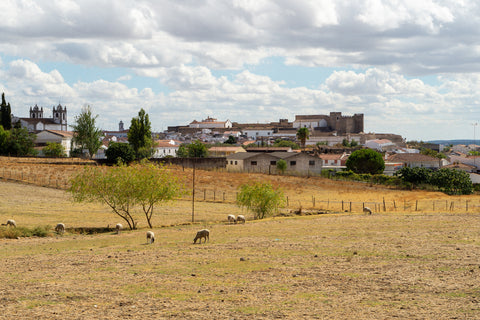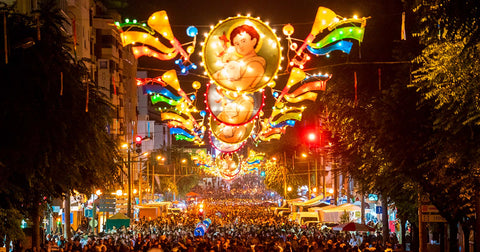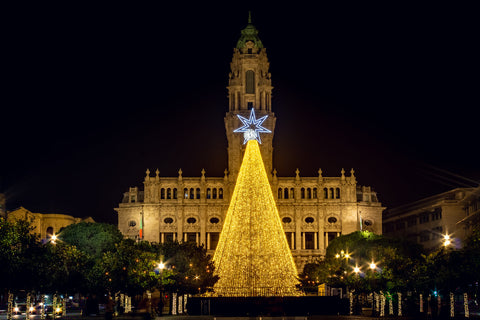Alentejo, a vast region located in the south of Portugal, is a true gem that is still little known to the general public. With its rolling landscapes, picturesque villages, rich history and delicious gastronomy, Alentejo embodies Portuguese authenticity in all its splendor. This region, often described as the quiet heart of Portugal, seduces with its peaceful pace of life and unique cultural heritage.
The first human traces
The history of Alentejo goes back thousands of years, with traces of human settlement dating back to prehistoric times. The numerous megaliths, dolmens and cromlechs scattered throughout the region bear witness to the presence of the first civilizations. Among the most emblematic sites, the Cromlech of Almendres, near Évora , is one of the largest megalithic complexes in Europe.
Roman and Moorish heritage
Over the centuries, Alentejo has been marked by various civilizations, including the Romans and the Moors. The Romans left an indelible mark on the region, building cities, roads and aqueducts. Évora , one of the main cities of Alentejo, is home to many Roman remains, including the famous Roman Temple , formerly known as the "Temple of Diana".

| Source: www.visitevora.net |
The Moors , who ruled the Alentejo for several centuries, also had a profound influence on local architecture and culture. Their fortresses and castles, often perched on hills, today offer spectacular views of the surrounding landscapes.
Alentejo was also the scene of many medieval conflicts, especially during the Reconquista. Many fortified villages, such as Reguengos de Monsaraz and Marvão, bear witness to this tumultuous period. The cobbled streets, whitewashed houses and imposing castles are all traces of this rich medieval past.

| Narrow street in Campo Maior in the Alto Alentejo region, Portugal. |
Alto and Baixo Alentejo: cities and heritage
Alentejo is divided into two large sub-regions : Alto Alentejo (Upper Alentejo) and Baixo Alentejo (Lower Alentejo). These two sub-regions share common cultural traits , but are distinguished by their geography, history and main cities.
Alto Alentejo (Upper Alentejo)

The Alto Alentejo is the northern part of the region, close to the Centro and Ribatejo regions. It is characterized by more hilly and green landscapes , as well as historical influences marked by the Romans, Moors and medieval knights. It is a region rich in historical heritage, with castles, fortresses and remarkable monuments.
The main cities of Alto Alentejo are:
-
Évora: A UNESCO World Heritage Site, Évora is one of Portugal's most iconic cities, known for its Roman ruins, medieval cathedral and picturesque streets.
-
Portalegre: Located near the Spanish border, Portalegre is famous for its baroque buildings, palaces and churches, as well as its historic textile industry.
-
Elvas: A walled city also a UNESCO World Heritage Site, Elvas is surrounded by impressive ramparts and is home to several fortresses.
-
Marvão: Perched on a hill, Marvão is a small medieval town offering spectacular views of the surrounding region, with its castle and stone walls.
-
Estremoz: a fortified town famous for its white marble quarries, Estremoz is home to a renowned market, a castle and several historic buildings.
-
Alter do Chão: a historic town, it is known for breeding the Lusitano horse, a symbol of Portuguese equestrian culture.

Lower Alentejo

The Baixo Alentejo, located further south , is a region of plains and vast fields of crops , especially cereals, vines and olive trees. The climate here is warmer and drier, creating a typically Mediterranean landscape with gentle hills and endless horizons. The Baixo Alentejo is also famous for its olive oil production and rural traditions.
Here are the main cities of Baixo Alentejo:
-
Beja: Capital of Baixo Alentejo, Beja has a rich historical heritage, including a medieval castle, Roman remains and several museums. It is an important city for agriculture and local markets.
-
Serpa: Famous for its traditional cheese and its ramparts, Serpa is a charming town known for its gastronomy and medieval architecture.
-
Moura: Located near the Spanish border, Moura is a historic town, known for its olive groves and olive oil mills. It also has a castle and several monuments.
-
Aljustrel: A traditional mining town, Aljustrel is renowned for its industrial heritage linked to copper mining. There are also interesting churches and monuments.
-
Mértola: A medieval town located on the banks of the Guadiana River, Mértola is distinguished by its Moorish and Roman history, and its unique archaeological heritage.
-
Alvito: A quiet and picturesque little town, Alvito is surrounded by vineyards and hills, and is home to a castle now converted into a pousada (historic hotel).

| Source: www.agroportal.pt |
The natural wealth of Alentejo
Alentejo is a region of contrasting landscapes , from vast golden plains to lush green mountains. Olive groves, vineyards and cork oak plantations dominate the landscape, creating a mosaic of colours and textures. Rivers, lakes and dams add a touch of freshness to this picturesque picture, providing popular places for relaxation for locals and visitors alike.
The Costa Vicentina Natural Park
The west coast of Alentejo is home to one of the most beautiful nature reserves in Portugal: the Southwest Alentejo and Costa Vicentina Natural Park. This protected area, which stretches over 100 km of coastline, is a true paradise for nature lovers; wild beaches, steep cliffs, and exceptional biodiversity make it a destination of choice for hikers and surfers.

| Source: www.visitportugal.com |
Preserved flora and fauna
Alentejo is also known for its preserved flora and fauna. The region is home to many endemic species , some of which are protected. Birdwatchers can observe a wide variety of birds, especially in wetlands and nature reserves. The rural landscapes, meanwhile, are dotted with cork oaks , olive trees , pine trees and wild flowers , providing an idyllic setting for walks.

Simple and tasty cuisine
Alentejo gastronomy is a reflection of the region: simple, authentic and generous . Local products, such as olive oil, bread, cheese and aromatic herbs , occupy a central place in Alentejo cuisine. Among the emblematic dishes, we find the "açorda", a bread soup seasoned with garlic and coriander served with a poached egg, or the "migas", a dish based on crumbled bread and meat.

| Açorda alentejane, a typical dish of the region. |
Alentejo wines
Alentejo is also renowned for its wines, which are among the best in Portugal. The region, with an ideal climate for viticulture, produces powerful red wines and refreshing white wines . Local wineries, often family-run, offer tastings and tours that allow you to discover the secrets of Alentejo wine production.
Local products
Local products are at the heart of Alentejo cuisine ; olive oil, produced from local olives, is of exceptional quality and used in almost every dish. In our Portuguese online store, you will find premium olive oils from Alentejo, such as the organic extra virgin olive oil Amor é Cego or the extra virgin olive oil from Mainova , which will give a sophisticated finishing touch to your dishes.
Sheep and goat cheese, often seasoned with herbs, is another typical product of the region and a delight to enjoy with fresh bread. We recommend the cheese of the Um Grama brand, available here .
Finally, black pork , a regional specialty, is used to prepare many dishes, including the famous “porco à alentejana” ; it is a tasty mix of marinated pork and clams, all simmered in a rich sauce made with white wine, garlic, paprika and aromatic herbs such as coriander. The clams are added at the end of cooking, bringing a maritime and salty touch that contrasts perfectly with the richness of the meat. The dish is often served with fried potatoes, which soak up the delicious sauce, and garnished with fresh coriander for a touch of freshness.
The cultural and tourist impact Alentejo tick
Alentejo is a region rich in traditions and cultural heritage. Local festivals, such as religious festivals , agricultural fairs and music festivals , are an opportunity to discover the region's customs and popular arts. The "cante alentejano" , a traditional polyphonic song, has even been inscribed as an Intangible Cultural Heritage of Humanity by UNESCO.

Although the Alentejo is still relatively untouched by mass tourism, the region is attracting more and more visitors in search of authenticity and serenity. Rural cottages, charming hotels and guest houses offer an ideal setting to recharge your batteries and discover the natural beauty of the Alentejo. Wine and gastronomy tourism is also booming, with many tours organized around wines and local products.
An unforgettable journey to the heart of Alentejo
Alentejo is a region that deserves to be discovered for its natural wealth and unique cultural heritage. Between its breathtaking landscapes, its tasty cuisine and its deep-rooted traditions, Alentejo truly embodies the soul of Portugal.
Whether you are a nature lover, a history buff or an epicurean in search of new flavors, Alentejo offers you an unforgettable experience, far from the beaten track. Immerse yourself in this captivating region and let yourself be charmed by Alentejo, where every street corner, every dish and every landscape tells a story.
Have you ever had the opportunity to visit Alentejo? Share your experiences and impressions in the comments!





Comments (0)
There are no comments for this article. Be the first one to leave a message!